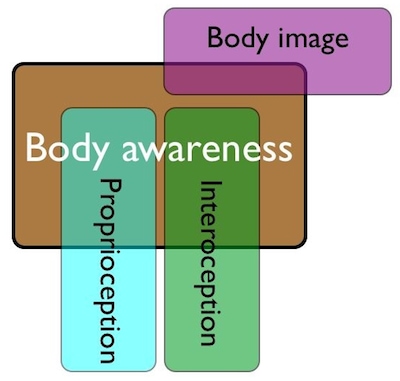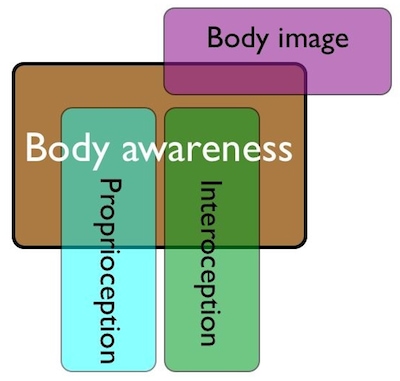Here at BiM, we do a bit of research that investigates what we call ‘bodily awareness’. We have incorporated some of that research into a recent review paper on bodily illusions in health and disease. Humbly speaking, that is worth a read if you are interested in the bodily illusions stuff like the rubber hand illusion and the use of vision to distort bodily awareness. That is not the point of this post however. The point of this post is to highlight a very decent systematic review from a couple of years ago. The paper looks at how we measure body awareness and whether the available measures (there are many of them) interrogate the same thing and how many related domains can justifiably be fit under the body awareness umbrella. I will return to what they think is good in a moment. What was surprising about this paper for me was the exhaustive nature of the introduction. The authors have given what I think is a lovely multidisciplinary narrative view of bodily awareness. Here are some things I think are relevant to us now:
Body awareness and body image are different: Body awareness is argued to be interoceptive – concerning our internal state (see also Bud Craig’s writing on this, which focusses on the neuroanatomical perspectives), whereas body image includes to some extent information on what our body looks like when observed from without. Body image is the common term in psychiatry literature on eating disorders primarily, and in feminist psychology – the objectification of women type work. I think our own work is less about body image and, for the sake of avoiding confusion, we would do well to not use the same label when we are not talking about those things.
From a physiological perspective, body awareness INCLUDES proprioception in addition to interoception. However, there are aspects of proprioception and interoception that do not reach awareness, so they fall outside of it.
Body awareness can be adaptive or maladaptive, in much the same way that pain can be adaptive or maladaptive. Indeed, the authors base their argument to a large part on the pain literature, but we could equally think about this when we think of nausea, which emerges into consciousness perhaps to warn us to make available the big porcelain bus in case we need a drive. Sometimes that is helpful because we have a tummy bug, sometimes it is not because we are overly attending to tummy-related input.
They spend some time on the philosophical angle of embodiment and the disquiet at modern Western society and its disembodying tendencies. Finally, they spend a good deal of time on mindfulness and the overlap between mindfulness and common therapeutic approaches, many of them targeting pain.
So, as you can see, by the time we get to the actual systematic review, we have waded through a very nice broad-based review of body awareness. I strongly recommend you read it if you are interested in this stuff (link to paper here).
This post is long, so i will cut to the chase with the recommendations from the review: They identified 12 satisfactory questionnaires. Two have documented reliability and only four have documented validity. There were 11 subdomains but no one questionnaire got all the subdomains covered. From a quality perspective, the Body Awareness Questionnaire, or BAQ, the Private Body Consciousness Sub-Scale (PBCS) of the Body Consciousness Questionnaire (BCQ), the Body Vigilance Scale. and the Scale of Body Connection. Rather than continue on here, if you are interested in the four key dimensions of body awareness identified by the review, and which questionnaires measure which, then you should check out the article itself here it is freely available for download as a PDF. The review does not conclude by saying ‘use this one’ because you really have to pick the questionnaire to fit your requirements. There is not doubt though, that the PBCS is the most studied and established. For now, I would recommend that one.
To conclude, it would be very interesting for us here at BiM to know how people are assessing body awareness, if you are at all. So, drop a comment in to tell us, particularly if you have any interested data to share. Does anyone assess it formally? If you assess it informally, how do you do it? Do you treat body awareness? If so, how do you measure your treatment?
About Lorimer Moseley
 Lorimer is NHMRC Senior Research Fellow with twenty years clinical experience working with people in pain. After spending some time as a Nuffield Medical Research Fellow at Oxford University he returned to Australia in 2009 to take up an NHMRC Senior Research Fellowship at Neuroscience Research Australia (NeuRA). In 2011, he was appointed Professor of Clinical Neurosciences & the Inaugural Chair in Physiotherapy at the University of South Australia, Adelaide. He runs the Body in Mind research groups. He is the only Clinical Scientist to have knocked over a water tank tower in Outback Australia.
Lorimer is NHMRC Senior Research Fellow with twenty years clinical experience working with people in pain. After spending some time as a Nuffield Medical Research Fellow at Oxford University he returned to Australia in 2009 to take up an NHMRC Senior Research Fellowship at Neuroscience Research Australia (NeuRA). In 2011, he was appointed Professor of Clinical Neurosciences & the Inaugural Chair in Physiotherapy at the University of South Australia, Adelaide. He runs the Body in Mind research groups. He is the only Clinical Scientist to have knocked over a water tank tower in Outback Australia.
Link to Lorimer’s published research here. Downloadable PDFs here.
Reference
Mehling WE, Gopisetty V, Daubenmier J, Price CJ, Hecht FM, & Stewart A (2009). Body awareness: construct and self-report measures. PloS one, 4 (5) e5614. doi:10.1371/journal.pone.0005614
Moseley GL, Gallace A, & Spence C (2011). Bodily illusions in health and disease: Physiological and clinical perspectives and the concept of a cortical ‘body matrix’ Neuroscience and biobehavioral reviews PMID: 21477616





